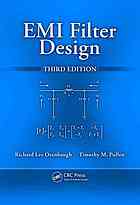

Most ebook files are in PDF format, so you can easily read them using various software such as Foxit Reader or directly on the Google Chrome browser.
Some ebook files are released by publishers in other formats such as .awz, .mobi, .epub, .fb2, etc. You may need to install specific software to read these formats on mobile/PC, such as Calibre.
Please read the tutorial at this link: https://ebookbell.com/faq
We offer FREE conversion to the popular formats you request; however, this may take some time. Therefore, right after payment, please email us, and we will try to provide the service as quickly as possible.
For some exceptional file formats or broken links (if any), please refrain from opening any disputes. Instead, email us first, and we will try to assist within a maximum of 6 hours.
EbookBell Team

0.0
0 reviewsWith today’s electrical and electronics systems requiring increased levels of performance and reliability, the design of robust EMI filters plays a critical role in EMC compliance. Using a mix of practical methods and theoretical analysis, EMI Filter Design, Third Edition presents both a hands-on and academic approach to the design of EMI filters and the selection of components values. The design approaches covered include matrix methods using table data and the use of Fourier analysis, Laplace transforms, and transfer function realization of LC structures. This edition has been fully revised and updated with additional topics and more streamlined content.
New to the Third Edition:
- Analysis techniques necessary for passive filter realization;
- Matrix method and transfer function analysis approaches for LC filter structure design;
- A more hands-on look at EMI filters and the overall design process.
Through this bestselling book’s proven design methodology and practical application of formal techniques, readers learn how to develop simple filter solutions. The authors examine the causes of common- and differential-mode noise and methods of elimination, the source and load impedances for various types of input power interfaces, and the load impedance aspect of EMI filter design. After covering EMI filter structures, topologies, and components, they provide insight into the sizing of components and protection from voltage transients, discuss issues that compromise filter performance, and present a goal for a filter design objective. The text also includes a matrix method for filter design, explains the transfer function method of LC structures and their equivalent polynomials, and gives a circuit design example and analysis techniques. The final chapter presents packaging solutions of EMI filters.